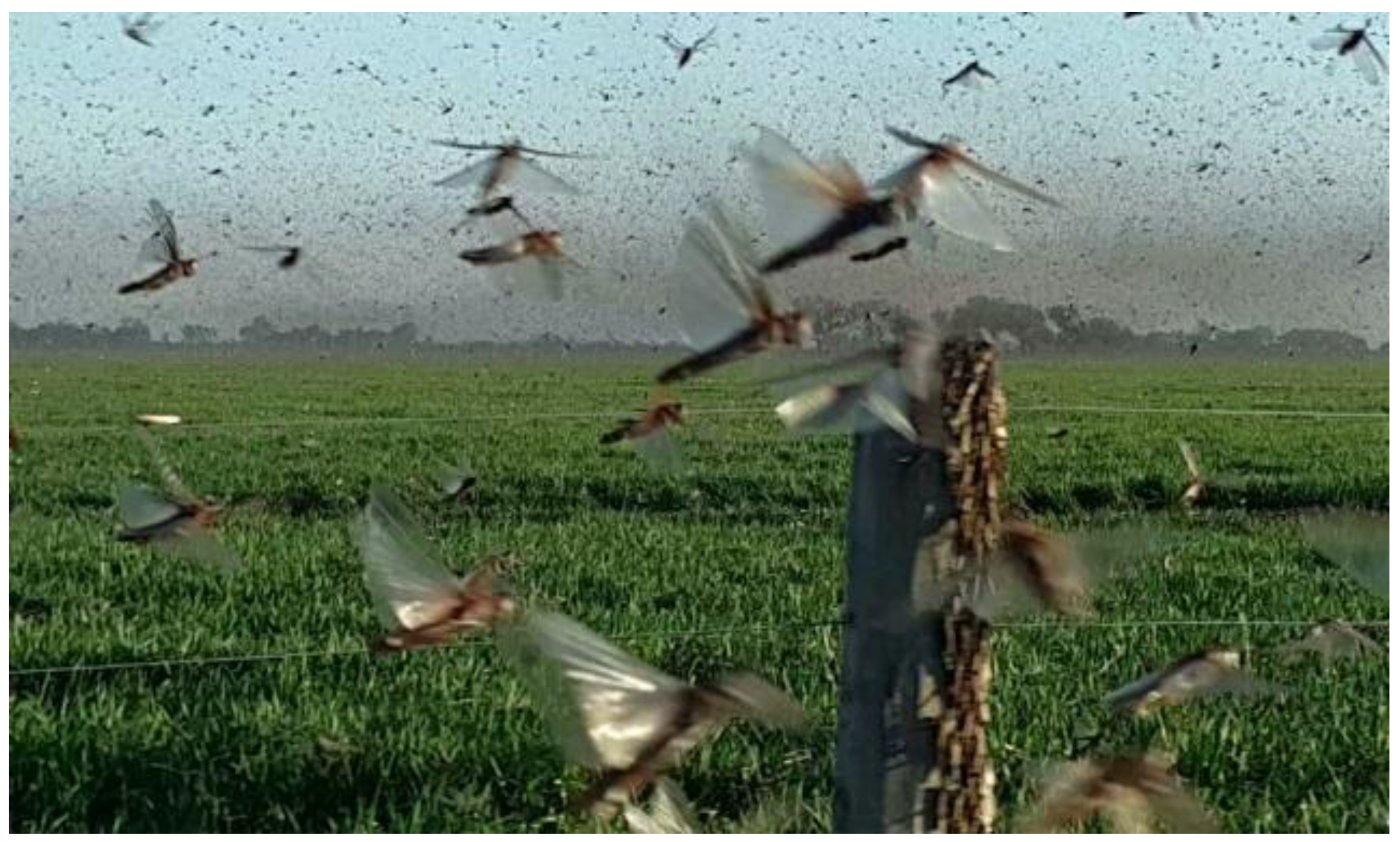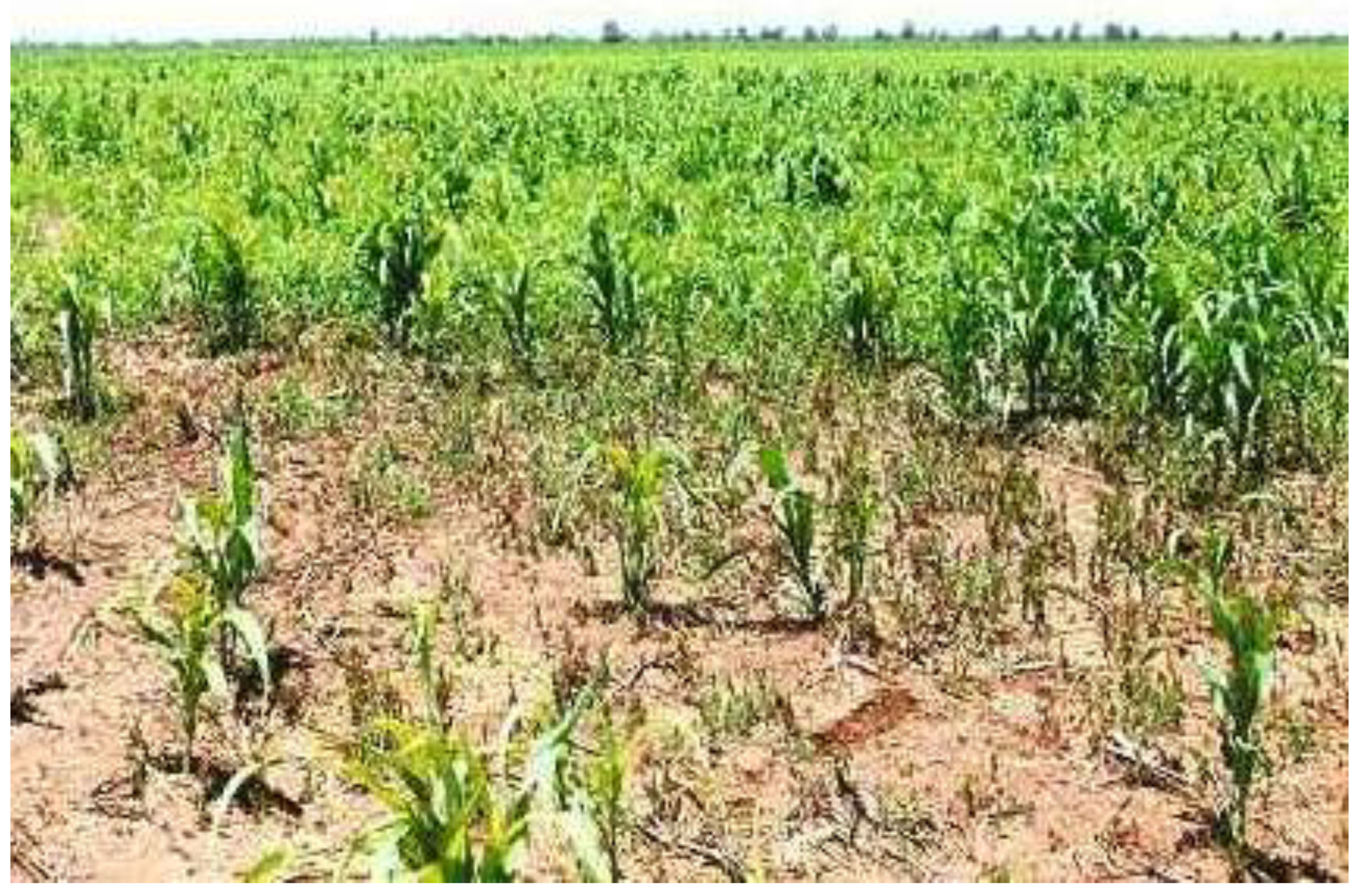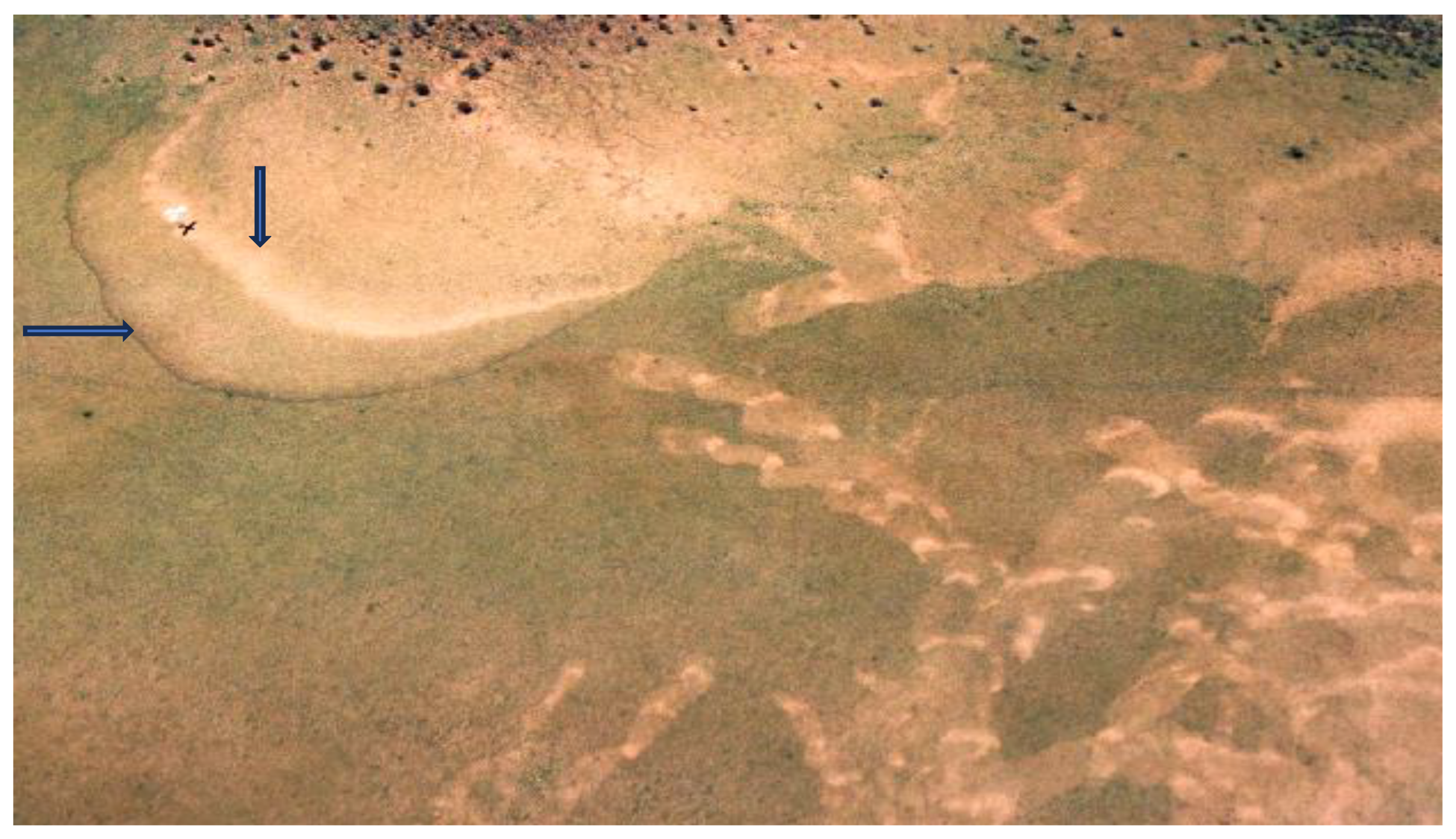World’s Best Practice Locust and Grasshopper Management: Accurate Forecasting and Early Intervention Treatments Using Reduced Chemical Pesticide
Abstract
:1. Introduction
2. Basis of Preventive Management: Forecasting Where Infestations Are Likely
3. Survey of Locusts and Grasshoppers
4. Locust and Grasshopper Control Using a Variety of Techniques
4.1. Preventive Management with Reduced Chemical Pesticide Use
4.2. Chemical Pesticide Spraying of Nymphs: Blanket Treatments vs. Strip Spraying
4.3. Treatments of Flying vs. Roosting Swarms
4.4. Biopesticides: An Important Part of Treatment Programs
5. Conclusions
Funding
Acknowledgments
Conflicts of Interest
References
- Lecoq, M. Desert locust threat to agricultural development and food security and FAO/International role in its control. Arab Soc. Plant Prot. 2003, 21, 188–193. [Google Scholar]
- Zhang, L.; Lecoq, M.; Latchininsky, A.; Hunter, D. Locust and grasshopper management. Ann. Rev. Entomol. 2019, 64, 15–34. [Google Scholar] [CrossRef] [PubMed]
- Lecoq, M.; Zhang, L. Encyclopedia of Pest Orthoptera of the World; China Agricultural University Press: Beijing, China, 2019. [Google Scholar]
- FAO Food and Agricultural Organization Locust Watch Central Asia and Caucasus 2024. Available online: https://www.fao.org/locust-watch/en (accessed on 10 October 2024).
- Gastón, J. Síntesis Histórica de las Invasiones de Langosta en la Argentina. Publicación Miscelánea 433; Secretaria de Estado de Agricultura y Ganaderia de la República Argentina: Buenos Aires, Argentina, 1969; 30p. [Google Scholar]
- Bahana, J.W.; Byaruhanga, E.K. Advances and review of strategies for red locust plague prevention: The control of red locust, Nomadacris septemfasciata (Serville) into the 21st century. Insect Sci. Appl. 1999, 19, 265–272. [Google Scholar] [CrossRef]
- Hunter, D.M. Advances in the control of locusts (Orthoptera: Acrididae) in eastern Australia: From crop protection to preventive control. Aust. J. Entomol. 2004, 43, 293–303. [Google Scholar] [CrossRef]
- Magor, J.I.; Lecoq, M.; Hunter, D.M. Preventive control and desert locust plagues. Crop Prot. 2008, 27, 1527–1533. [Google Scholar] [CrossRef]
- Zhang, L. Advances and prospects of strategies and tactics of locust and grasshopper management. Chin. J. Appl. Entomol. 2011, 48, 804–810. Available online: http://www.ent-bull.com.cn/viewmulu.aspx?qi_id=660&mid=16987&xuhao=2 (accessed on 10 October 2024). (In Chinese).
- Showler, A.T.; Ould Babah Ebbe, M.A.; Lecoq, M.; Maeno, K.O. Early intervention Against desert locusts: Current proactive approach and the prospect of sustainable outbreak prevention. Agronomy 2021, 11, 312. [Google Scholar] [CrossRef]
- Uvarov, B.P. Biological and ecological basis of locust phases and their practical application. In Proceedings of the Fourth International Locust Conference, Cairo, Egypt, 22 April 1936; Government Press: Cairo, Egypt, 1937. Appendix 7, 16p. [Google Scholar]
- Hunter, D.M.; Cozenzo, L.E. The origin of plagues and recent outbreaks of the South American Locust, Schistocerca cancellata (Orthoptera: Acrididae) in Argentina. Bull. Ent. Res. 1990, 80, 295–300. [Google Scholar] [CrossRef]
- Uvarov, B.P. The aridity factor in the ecology of locusts and grasshoppers of the old world. In Arid Zone Research. VII. Human and Animal Ecology: Reviews of Research; UNESCO: Paris, France, 1957; pp. 164–168. [Google Scholar]
- Waloff, Z. The upsurge and recessions of the desert locust plague: An historical survey. Anti-Locust Mem. 1966, 8, 111. [Google Scholar]
- Hunter, D.M. Distribution of the Australian plague locust in the Channel Country and adjacent areas. In Australian Plague Locust Commission; Ann. Report 1980–1981, Research; Supplement Australian Government Publishing Service: Canberra, Australia, 1982; pp. 46–54. [Google Scholar]
- McCulloch, L.; Hunter, D.M. Identification and monitoring of Australian plague locust habitats from Landsat. Remote Sens. Env. 1982, 13, 95–102. [Google Scholar] [CrossRef]
- Gay, P.; Lecoq, M.; Piou, C. Improving preventive locust management: Insights from a multi-agent model. Pest Manag. Sci. 2018, 74, 46–58. [Google Scholar] [CrossRef] [PubMed]
- Gay, P.; Lecoq, M.; Piou, C. The limitations of locust preventive management faced with spatial uncertainty: Exploration with a multi-agent model. Pest Manag. Sci. 2020, 76, 1094–1102. [Google Scholar] [CrossRef] [PubMed]
- Lecoq, M. Recent progress in desert and migratory locust management in Africa. Are preventive actions possible? J. Orthopt. Res. 2001, 10, 277–291. [Google Scholar] [CrossRef]
- Lockwood, J.A.; Schowler, A.T.; Latchininsky, A.V. Can we make locust and grasshopper management sustainable? J. Orthopt. Res. 2001, 10, 315–329. [Google Scholar] [CrossRef]
- Belayneh, Y.T. Acridid pest management in the developing world: A challenge to the rural population, a dilemma to the international community. J. Orthopt. Res. 2005, 14, 187–195. [Google Scholar] [CrossRef]
- Strategic Review of the Australian Plague Locust Commission (APLC) 2012. 37p. Available online: https://www.agriculture.gov.au/sites/default/documents/aplc-strategic-review-2012.pdf (accessed on 10 October 2024).
- Song, H. Density-dependent phase polyphenism in Nonmodel locusts: A minireview. Pysche 2011, 2011, 741769. [Google Scholar] [CrossRef]
- Hunter, D.M.; Elder, R.J. Rainfall sequences leading to population increases of Austracris guttulosa (Walker) (Orthoptera:Acrididae) in arid north-eastern Australia. Aust. J. Entomol. 1999, 38, 204–218. [Google Scholar] [CrossRef]
- Zhang, L.; Hunter, D.M. Management of locusts and grasshoppers in China. J. Orthopt. Res. 2017, 26, 155–159. [Google Scholar] [CrossRef]
- Food and Agricultural Organization Desert Locust. 2024. Available online: https://www.fao.org/locusts/en (accessed on 10 October 2024).
- Deveson, E.D.; Hunter, D.M. The operation of a GIS-based decision support system for Australian locust management. Entomol. Sin. 2002, 9, 1–12. [Google Scholar] [CrossRef]
- Australian Plague Locust Commission. 2024. Available online: https://www.agriculture.gov.au/biosecurity-trade/pests-diseases-weeds/locusts (accessed on 10 October 2024).
- Cressman, K. The use of new technologies in desert locust early warning. Outlooks Pest Manag. 2008, 19, 55–59. [Google Scholar] [CrossRef]
- Cressman, K. Desert Locust. In Biological and Environmental Hazards, Risks, and Disasters; Sivanpillai, R., Ed.; Elsevier: Amsterdam, The Netherlands, 2016; pp. 87–105. [Google Scholar] [CrossRef]
- Li, L.; Zhu, D.; Ye, S.; Yao, X. Design and implementation of geographic information systems, remote sensing, and global positioning system–based information platform for locust control. J. Appl. Remote Sens. 2014, 8, 084899. [Google Scholar] [CrossRef]
- Hastings, J.; Latchininsky, A.V.; Schell, S.P. Sustainability of grasshopper management and support through CARMA. In Proceedings of the 42nd Hawaii International Conference on Systems Sciences (HICSS 2009), Waikoloa, HI, USA, 5–8 January 2009; IEEE Computer Society: Washington, DC, USA, 2009; pp. 1–10. [Google Scholar] [CrossRef]
- Deveson, E.D.; Drake, V.A.; Hunter, D.M.; Walker, P.W.; Wang, H.K. Evidence from traditional and new technologies for northward migrations of Australian plague locusts, Chortoicetes terminifera (Walker) (Orthoptera: Acrididae) to western Queensland. Austral Ecol. 2005, 30, 928–943. [Google Scholar] [CrossRef]
- Lecoq, M.; Sukirno. Drought and exceptional outbreak of the oriental migratory locust in Indonesia. J. Orthopt. Res. 1999, 8, 153–161. [Google Scholar] [CrossRef]
- Cease, A.J.; Elser, J.J.; Ford, C.F.; Hao, S.; Kang, L.; Harrison, J.F. Heavy livestock grazing promotes locust outbreaks by lowering plant nitrogen content. Science 2012, 335, 467–469. [Google Scholar] [CrossRef] [PubMed]
- Stige, L.C.; Chan, K.S.; Zhang, Z.B.; Frank, D.; Stenseth, N.C. Thousand-year-long Chinese time series reveals clmatic forcing of decadal locust dynamics. Proc. Natl. Acad. Sci. USA 2007, 104, 16188–16193. [Google Scholar] [CrossRef]
- Joern, A. What are the consequences of non-linear ecological interactions for grasshopper control strategies? In Grasshoppers and Grassland Health. Managing Grasshopper Outbreaks without Risking Environmental Disaster: NATO Science Series 2. Environmental Security—Vol. 73; Lockwood, J.A., Latchininsky, A.V., Sergeev, M.G., Eds.; Kluwer Academic Publishers: Dordrecht, The Netherlands, 2000; pp. 131–144. [Google Scholar] [CrossRef]
- Baker, G.L. The seasonal abundance of dipterous and mermithid parasites of the wingless grasshopper Phaulacridium vittatum (Sjost) in the Central Tablelands of New South Wales. In Proceedings of the 3rd Australasian Conference on Grassland Invertebrate Ecology; Lee, K., Ed.; Government Printing Division: Adelaide, Australia, 1982; pp. 169–176. [Google Scholar]
- Symmons, P. Evaluating recent locust research. In New Strategies in Locust Control; Krall, S., Peveling, R., Diallo, B.D., Eds.; Birkhäuser Verlag: Basel, Switzerland, 1997; pp. 2–8. Available online: http://link.springer.com/chapter/10.1007/978-3-0348-9202-5_1 (accessed on 10 October 2024).
- Hunter, D.M.; McCulloch, L.; Spurgin, P.A. Aerial detection of nymphal bands of the Australian plague locust (Chortoicetes terminifera (Walker)) (Orthoptera: Acrididae). Crop Prot. 2008, 27, 118–123. [Google Scholar] [CrossRef]
- Owour, A.; McRae, H.D. The control of the desert locusts (Schistocerca gregaria) in Somalia during the upsurge between 2019 and 2021. Outlooks Pest Manag. 2022, 33, 221–226. [Google Scholar] [CrossRef]
- Gensch, L.; Jantke, K.; Rasche, L.; Schneider, U.A. Pesticide risk assessment in European agriculture: Distribution patterns, ban-substitution effects and regulatory implications. Environ. Pollut. 2024, 348, 123836. [Google Scholar] [CrossRef]
- Everts, J.W.; Ba, L. Environmental effects of locust control: State of the art and perspectives. In New Strategies in Locust Control; Krall, S., Peveling, R., Diallo, B.D., Eds.; Birkhäuser Verlag: Basel, Switzerland, 1997; pp. 331–336. [Google Scholar] [CrossRef]
- Samways, M.J. Can locust control be compatible with conserving biodiversity? In Grasshoppers and Grassland Health. Managing Grasshopper Outbreaks without Risking Environmental Disaster; Lockwood, J.A., Latchininsky, A.V., Sergeev, M.G., Eds.; Kluwer Academic Publishers: Dordrecht, The Netherlands, 2000; pp. 173–180. Available online: http://link.springer.com/chapter/10.1007/978-94-011-4337-0_12 (accessed on 10 October 2024).
- Smith, D.I.; Lockwood, J.A.; Latchininsky, A.V.; Legg, D.E. Changes in non-target arthropods populations following application of liquid bait formulations of insecticides for control of rangeland grasshoppers. Int. J. Pest Manag. 2006, 52, 125–139. [Google Scholar] [CrossRef]
- Lockwood, J.A.; Schell, S.P. Decreasing economic and environmental costs through Reduced Area and Agent Insecticide Treatments (RAATs) for the control of rangeland grasshoppers: Empirical results and their implications for pest management. J. Orthopt. Res. 1997, 6, 19–32. [Google Scholar] [CrossRef]
- Lockwood, J.A.; Anderson-Sprecher, R.; Schell, S.P. When less is more: Optimization of reduced agent-area treatments (RAATs) for management of rangeland grasshoppers. Crop Prot. 2002, 21, 551–562. [Google Scholar] [CrossRef]
- McNary, T.J.; Shambaugh, B.A.; Elliston, R.J.; Brown, C.L. Cooperative rangeland grasshopper suppression in Wyoming (USA) in 2010. Metaleptea 2011, 31, 10–12. [Google Scholar]
- Food and Agriculture Organization. PGSE—Plan de Gestion Sanitaire et Environnementale Relative à la lutte Antiacridienne à Madagascar; Food and Agricultural Organization: Rome, Italy, 2013; 103p, Available online: http://www.fao.org/3/a–bl257f.pdf (accessed on 12 October 2024).
- Henschel, J.R. Locust times—Monitoring populations and outbreak controls in relation to Karoo natural capital. Trans. R. Soc. S. Afr. 2015, 70, 135–143. [Google Scholar] [CrossRef]
- Peveling, R. Environmental conservation and locust control—Possible conflicts and solutions. J. Orthopt. Res. 2001, 10, 171–187. [Google Scholar] [CrossRef]
- Rachadi, T.; Foucart, A. Barrier treatment with fipronil to control desert locust Schistocerca gregaria (Forskål, 1775) hopper bands infesting a large area in Mauritania. Int. J. Pest Manag. 1999, 45, 263–273. [Google Scholar] [CrossRef]
- Samways, M.J.; Lockwood, J.A. Orthoptera conservation: Pests and paradoxes. J. Insect Conserv. 1998, 2, 143–149. [Google Scholar] [CrossRef]
- Latchininsky, A.V.; Schell, S.P. Grasshoppers in the West: Identification and Management; Cooperative Extension Service Bulletin B-1171; University of Wyoming: Laramie, WY, USA, 2006; Available online: https://www.wyoextension.org/agpubs/pubs/B1171_poster.pdf (accessed on 10 October 2024).
- van der Valk, H. The impact of locust and grasshopper control on beneficial arthropods in West Africa. In Ecotoxocology: Pesticides and Beneficial Organisms; Haskell, P.T., McEwen, P., Eds.; Chapman & Hall: London, UK, 1998; pp. 372–380. [Google Scholar] [CrossRef]
- Hunter, D.M.; Milner, R.J.; Spurgin, P.A. Aerial treatment of the Australian plague locust, Chortoicetes terminifera (Orthoptera: Acrididae) with Metarhizium anisopliae (Deuteromycotina: Hyphomycetes). Bull. Entomol. Res. 2001, 91, 93–99. [Google Scholar] [CrossRef]
- Hernández-Velazquez, V.M.; Hunter, D.M.; Barrientos-Lozano, L.; Lezama-Guiterrez, R.; Reyes-Villanueva, F. Susceptibility of Schistocerca piciefrons (Orthoptera: Acrididae) to Metarhizium anisopliae var. acridum (Deuteromycotina: Hyphomycetes): Laboratory and field trials. J. Orthopt. Res. 2003, 12, 89–92. [Google Scholar] [CrossRef]
- Barrientos-Lozano, L.; Hunter, D.M.; Alvila-Valdez, J.; Garcia-Salazar, P.; Horta Vega, J.V. Control biológico de la langosta Schistocerca piceifrons (Orthoptera: Acrididae) en el noroeste de Mexico. Vedalia 2005, 12, 119–128. [Google Scholar]
- Barrientos-Lozano, L.; Song, H.; Rocha-Sanchez, A.Y.; Torres-Castillo, J.A. State of the art management of the Central American zlocvust Schistocerca piciefrons piciefrons (Walker, 1870). Agronomy 2021, 11, 1024. [Google Scholar] [CrossRef]
- Zhang, L.; Hunter, D.M. Laboratory and field trials of Green GuardTM Metarhizium anisopliae var. acridum (Deuteromycotina: Hyphomycetes) against the oriental migratory locust (Locusta migratoria manilensis) (Orthoptera: Acrididae) in China. J. Orthopt. Res. 2005, 14, 27–30. [Google Scholar] [CrossRef]
- Li, H.M.; Kadzamira, M.A.T.J.; Ogimmodede, A.; Finch, E.; Xhu, J.Q.; Romney, D.; Luke, B. Lessons learned and challenges of biopesticide usage for locust management—The case of China. Sustainablility 2023, 15, 6193. [Google Scholar] [CrossRef]
- Belovsky, G.E. Do grasshoppers diminish grassland productivity? A new perspective for control based on conservation. In Grasshoppers and Grassland Health. Managing Grasshopper Outbreaks without Risking Environmental Disaster; Lockwood, J.A., Latchininsky, A.V., Sergeev, M.G., Eds.; Kluwer Academic Publishers: Dordrecht, The Netherlands, 2000; pp. 7–30. [Google Scholar] [CrossRef]
- Latchmininsky, A.V.; Sword, G.; Sergeev, M.; Cigliano, M.M.; Lecoq, M. Locusts and grasshoppers: Behavior, ecology, and biogeography. Psyche—J. Entomol. 2011, 2011, 578327. [Google Scholar] [CrossRef]
- Zhang, L.; Yan, Y.; Wang, G.; Zhang, Z.; Pan, J.; Yang, Z. A preliminary survey on the epizootics of infection of Nosema locustae among grasshoppers in rangeland. Acta Agrestica Sin. 1995, 3, 223–229. Available online: http://manu40.magtech.com.cn/Jweb_cdxb/CN/10.11733/j.issn.1007-0435.1995.03.007 (accessed on 10 October 2024).
- Gong, A.; Liu, X.; Jiang, X.; Zhang, L. Transmission of Nosema locustae disease in grasshopper populations in Qinghai grassland. Chin. J. Biol. Control 2003, 19, 118–121. Available online: http://en.cnki.com.cn/Article_en/CJFDTOTAL-ZSWF200303006.htm (accessed on 10 October 2024).
- Fu, X.J.; Hunter, D.M.; Shi, W.P. Effect of Paranosema (Nosema) locustae (Microsporidia) on morphological phase transformation of Locusta migratoria manilensis (Orthoptera: Acrididae). Biocontrol Sci. Technol. 2010, 20, 683–693. [Google Scholar] [CrossRef]
- Hunter, D.M. Credibility of an IPM approach for locust and grasshopper control: The Australian example. J. Orthopt. Res. 2010, 19, 133–137. [Google Scholar] [CrossRef]
- Zhang, L.; Lecoq, M. Nosema locustae (Protozoa, Microsporidia), a biological agent for locust and grasshopper control. Agronomy 2021, 11, 711. [Google Scholar] [CrossRef]
- Ouedraogo, A.; Fargues, J.; Goettel, M.; Lomer, C.J. Effect of temperature on vegetative growth among isolates of Metarhizium anisopliae and M. flavoviride. Mycopathologia 1997, 137, 37–43. [Google Scholar] [CrossRef]
- Milner, R.J. Metarhizium fjlavoviridae (FI985) as a promising mycoinsecticide for Australian acridids. Mem. Entomol. Soc. Can. 1997, 171, 287–300. [Google Scholar] [CrossRef]
- Finch, E.A.; Li, H.M.; Cornelius, A.; Styles, J.; Beeken, J.; Cheng, Y.M.; Wang, G.J.; Qui, G.G.; Luke, B. An updated and validated model for predicting the performance of a biological control agent for the oriental migratory locust. Pest Manag. Sci. 2024, 80, 442–451. [Google Scholar] [CrossRef] [PubMed]
- Keyser, C.A.; Fernandes, E.K.K.; Rangel, D.E.N.; Roberts, D.W. Heat-induced post-stress growth delay: A biological trait of many Metarhizium isolates reducing biocontrol efficacy? J. Invert. Pathol. 2014, 120, 67–73. [Google Scholar] [CrossRef] [PubMed]
- Scattolini, M.C.; Piou, C.; Medina, H.; Iglesias, R.; Cerquetti, A.; Cigliano, M.M. Environmental factors associated to breeding areas of the South American locust Schistocerca cancellata on a regional scale. Austral Ecol. 2024, 49, e13568. [Google Scholar] [CrossRef]
- Wang, B.; Deveson, E.D.; Waters, C.; Spessa, A.; Lawton, D.; Feng, P.; Liu, D.L. Future climate change likely to reduce the Australian plague locust (Chortoicetes terminifera) seasonal outbreaks. Sci. Total Environ. 2019, 668, 947–957. [Google Scholar] [CrossRef]




| Origin | Species | Commercial Name | Biopesticide Strain |
|---|---|---|---|
| Africa | M. acridum | Green Muscle | IMI 330189 |
| Africa | M. acridum | Novacrid | EVCH 077 |
| Australia | M. acridum | Green Guard | FI-985 |
| China | M. anisopliae | -- | CQMa102 |
| China | N. locustae | -- | AL200804 |
| México | M. acridum | Metacridum | MaPL40 |
Disclaimer/Publisher’s Note: The statements, opinions and data contained in all publications are solely those of the individual author(s) and contributor(s) and not of MDPI and/or the editor(s). MDPI and/or the editor(s) disclaim responsibility for any injury to people or property resulting from any ideas, methods, instructions or products referred to in the content. |
© 2024 by the author. Licensee MDPI, Basel, Switzerland. This article is an open access article distributed under the terms and conditions of the Creative Commons Attribution (CC BY) license (https://creativecommons.org/licenses/by/4.0/).
Share and Cite
Hunter, D. World’s Best Practice Locust and Grasshopper Management: Accurate Forecasting and Early Intervention Treatments Using Reduced Chemical Pesticide. Agronomy 2024, 14, 2369. https://doi.org/10.3390/agronomy14102369
Hunter D. World’s Best Practice Locust and Grasshopper Management: Accurate Forecasting and Early Intervention Treatments Using Reduced Chemical Pesticide. Agronomy. 2024; 14(10):2369. https://doi.org/10.3390/agronomy14102369
Chicago/Turabian StyleHunter, David. 2024. "World’s Best Practice Locust and Grasshopper Management: Accurate Forecasting and Early Intervention Treatments Using Reduced Chemical Pesticide" Agronomy 14, no. 10: 2369. https://doi.org/10.3390/agronomy14102369
APA StyleHunter, D. (2024). World’s Best Practice Locust and Grasshopper Management: Accurate Forecasting and Early Intervention Treatments Using Reduced Chemical Pesticide. Agronomy, 14(10), 2369. https://doi.org/10.3390/agronomy14102369






